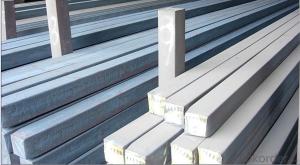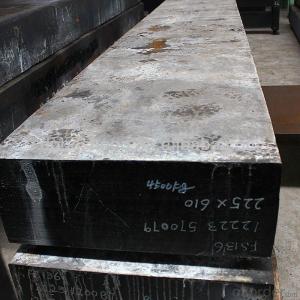Square Steel Billet Q235 Grade Prime Quality 8#
- Loading Port:
- Tianjin
- Payment Terms:
- TT OR LC
- Min Order Qty:
- 2000 m.t
- Supply Capability:
- 50000 m.t/month
OKorder Service Pledge
OKorder Financial Service
You Might Also Like
Description of Square Steel Billet Q235 Grade Prime Quality 8#
M. S. Billets are used for rolling of TMT Re-Bars of Fe415 and Fe500 Grade and various other structural steel products.
CRS Billets are used for rolling of CRS TMT Re-Bars.
Special Alloy Billets are used for rolling of any special grade TMT Re-Bars like Earthquake resistant TMT Re-Bars and for special grade structural steel products.
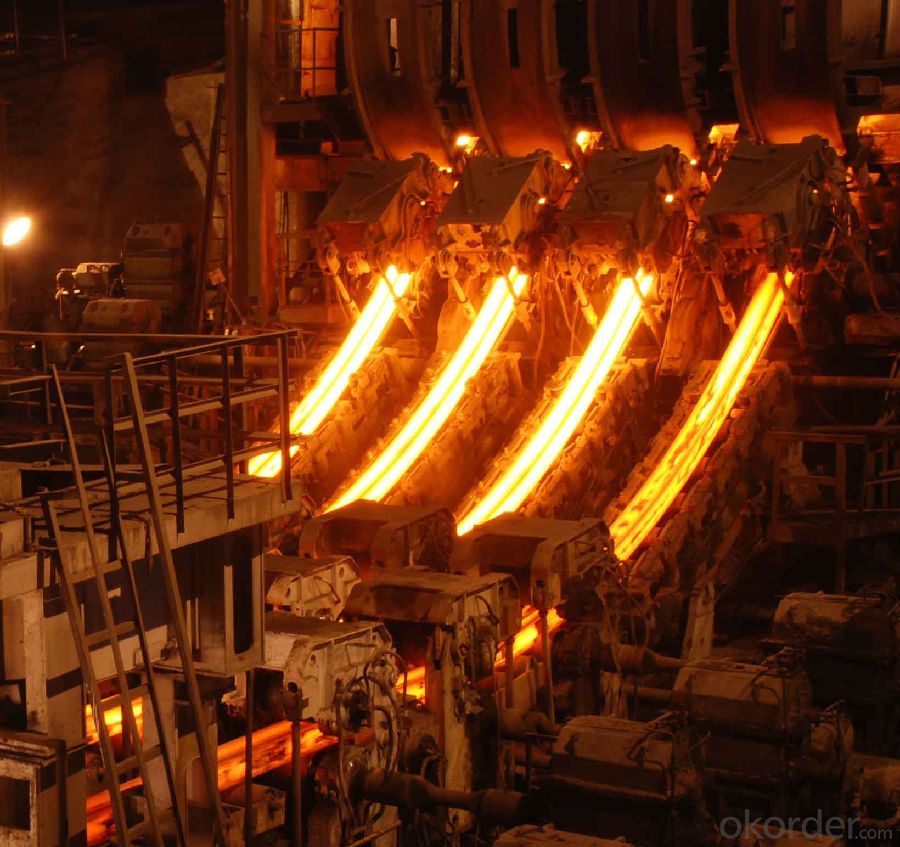
Main Feature Square Steel Billet Q235 Grade Prime Quality 8#
Raw elements(C,Fe,Ni,Mn,Cr,Cu.)---Smelted ingots by AOD finery---hot rolled into black suface---pickling in acid liquid---cold drawn----polished by automatically machine--- cutting into pieces---checking quanlity
Applications of Square Steel Billet Q235 Grade Prime Quality 8#
Widely Used in the areas such as Stainless Steel Fasteners, Chains, Kitchen and Sanitary wares, Furniture handles, Handrails, Electroplating and Electrolyzing pendants, Foods, Electron, Petroleum, Construction and Decoration, etc. Products have a high strength after cold-working. Electronic products parts, Medical appliance, Springs, Bus Inside and Outside packaging and building, Street Lamp Posts, etc. Decoration materials and Outdoor Publicity Billboard. Used for the products which have the Anti-Stress Corrosion requirement. Electron Products, Table-wares, Bolts, Nuts, Screen Meshes, Cumbustors and so on.
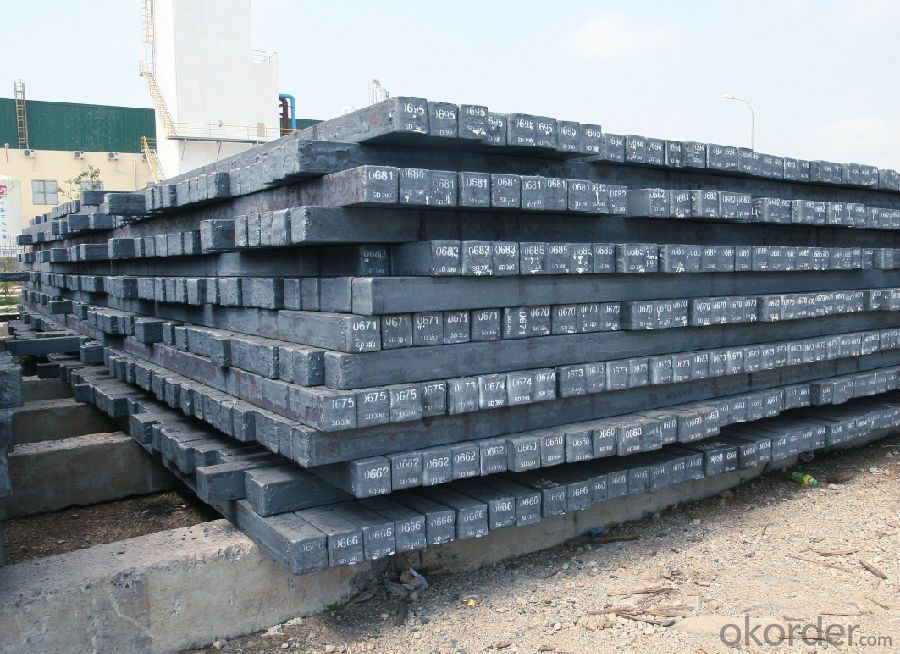
Specifications of Square Steel Billet Q235 Grade Prime Quality 8#
| Standard | C(%) | Mn(%) | S(%) | P(%) | Si(%) |
| Q195 | ≤0.12 | ≤0.50 | ≤0.040 | ≤0.035 | ≤0.30 |
| Q235 | ≤0.20 | ≤1.40 | ≤0.045 | ≤0.045 | ≤0.35 |
| Q275 | ≤0.22 | ≤1.50 | ≤0.045 | ≤0.045 | ≤0.35 |
| 20MnSi | 0.17-0.25 | 1.2-1.6 | ≤ 0.050 | ≤ 0.050 | 0.40-0.80 |
| 3SP | 0.14-0.22 | 0.40-0.85 | ≤ 0.050 | ≤ 0.040 | 0.05-0.15 |
| 5SP | 0.28-0.37 | 0.50-1.00 | ≤ 0.050 | ≤ 0.040 | 0.15-0.30 |
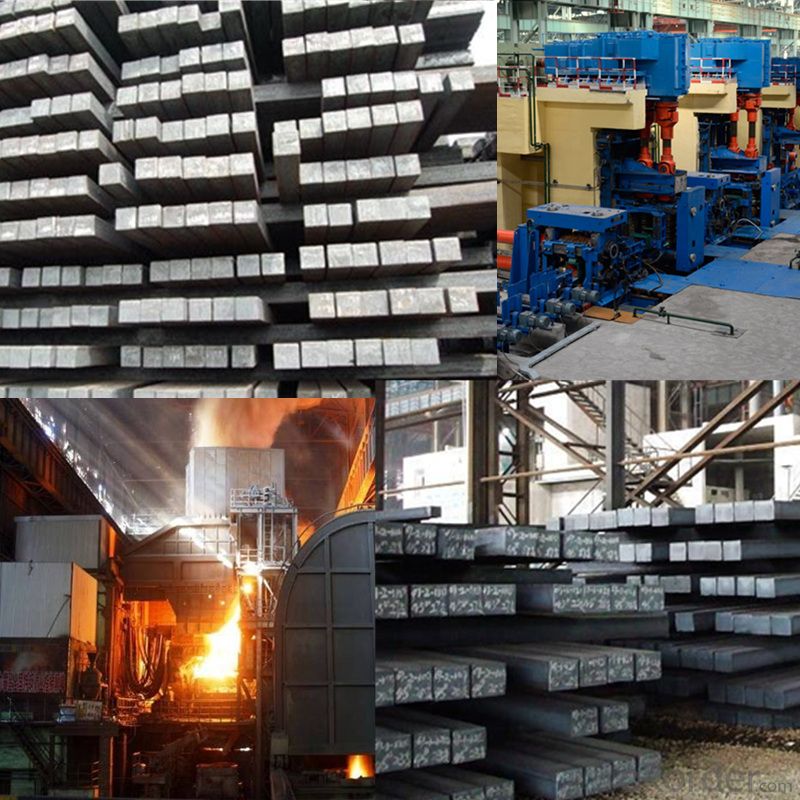
FAQ of Square Steel Billet Q235 Grade Prime Quality 8#
We have organized several common questions for our clients,may help you sincerely:
1. How Can I Visit There?
Our company is located in Tianjin City, China, near Beijing. You can fly to Tianjin Airport Directly. All our clients, from home or aboard, are warmly welcome to visit us!
2. How Can I Get Some Sample?
We are honored to offer you sample.
3. Why choose CNBM?
Our delivery time about 15-20days for standard sizes, if you have other requirements like hardness, quanity and width ,it is about 20-40days. But don't worry we also try our best for the delivery time ,because time longer and our cost is higher.
- Q:What is the difference between steel billets and steel ingots?
- Steel billets and steel ingots, although both semi-finished steel products, differ in terms of their shape and manufacturing process. Rectangular or square-shaped bars, steel billets are typically produced through a continuous casting process. This process involves pouring molten steel into molds, allowing it to solidify into the desired shape. Billets are commonly used as raw material for further processing, such as rolling or forging, to create finished steel products like bars, rods, or wire. On the contrary, steel ingots are large, solid blocks of steel that are usually produced through a traditional casting process. In this process, molten steel is poured into large molds, left to cool and solidify. Ingots are mainly used for the production of larger steel components or as feedstock for forging or rolling operations. Prior to being processed into the final product, they are often remelted and refined. In terms of size, billets are generally smaller, with a cross-sectional area ranging from 36 to 155 square inches. On the other hand, ingots are larger, with a cross-sectional area exceeding 155 square inches. Both steel billets and steel ingots act as intermediary products in the steel manufacturing industry. The decision to use billets or ingots depends on the specific requirements of the final steel product and the manufacturing process involved.
- Q:Iron type frequency furnace, billet 150, continuous casting billet between the hole, please help net friend to find the original, please ask non answer, not Xie, please mention, understand enough, please resume me
- 1: new furnace, new furnace lining contains more gas2: raw material no clean, no coincidence?3: melt protection? Temperature is not high, no refining and static?4:3 point, mold and traction to look for defects, mold cooling effect - water temperature - traction line and horizontal - traction process5: stop and pull
- Q:What is the cost of steel billets?
- The price of steel billets can fluctuate based on several factors, including the prevailing market conditions, the dynamics of supply and demand, the quality and specifications of the billets, as well as the purchasing location. Usually, steel billet prices are specified in metric tons or short tons. To obtain the most precise and current pricing information, it is recommended to refer to steel industry reports, market analysis, or contact steel suppliers or distributors.
- Q:How are steel billets used in the production of automotive suspension components?
- Steel billets are used in the production of automotive suspension components due to their strength, durability, and malleability. Billets are essentially semi-finished steel products that are formed into specific shapes, such as bars or rods, through a process called hot rolling. In the case of automotive suspension components, steel billets are first heated to a high temperature and then passed through a series of rollers to shape them into the desired form, such as coil springs, shock absorber rods, or stabilizer bars. The hot rolling process helps to refine the grain structure of the steel, resulting in improved mechanical properties. The use of steel billets in suspension components is crucial as they provide the necessary strength and stiffness to withstand the various forces and loads encountered during vehicle operation. Suspension components, such as coil springs, are responsible for supporting the weight of the vehicle and providing a comfortable ride by absorbing impacts and vibrations. Steel billets are preferred for automotive suspension components due to their high tensile strength, which allows them to withstand heavy loads and maintain their shape over long periods. Additionally, the malleability of steel allows for easy forming and shaping into various complex geometries, ensuring a precise fit and functionality within the suspension system. Moreover, steel billets offer excellent fatigue resistance, which is crucial for suspension components as they undergo repetitive loading and unloading throughout the vehicle's lifespan. This fatigue resistance helps to prevent failure and ensures a long-lasting and reliable suspension system. Overall, the use of steel billets in the production of automotive suspension components is essential for achieving the necessary strength, durability, and performance required for safe and comfortable vehicle operation.
- Q:What is the typical fatigue strength of a steel billet?
- The fatigue strength of a steel billet can vary based on factors like its specific steel composition, manufacturing process, and surface treatments utilized. Fatigue strength generally refers to a material's ability to endure repeated loading and unloading cycles without breaking. Compared to other materials, steel typically possesses high fatigue strength due to its strength and durability. However, the precise fatigue strength value can differ considerably depending on the steel grade and intended use. In engineering and industry, fatigue strength is often represented by a stress-life (S-N) curve. This curve depicts the stress level exerted on the steel billet versus the number of cycles required for failure. The curve's shape offers valuable insights into the steel's fatigue behavior. It is crucial to note that determining the fatigue strength of a steel billet usually involves rigorous testing procedures. Fatigue testing machines are employed to subject the material to cyclic loading until failure occurs. These tests assist engineers and manufacturers in establishing safe operating limits for various steel grades and applications. Consequently, without specific details regarding the steel grade, manufacturing process, and other factors, it is not feasible to provide an exact value for the typical fatigue strength of a steel billet. Nevertheless, it is widely acknowledged that steel possesses excellent fatigue resistance and can withstand a significant number of cycles before failure, rendering it a dependable choice for numerous structural and mechanical applications.
- Q:What are the potential applications of steel billets in the chemical industry?
- Steel billets have several potential applications in the chemical industry due to their unique properties and versatility. One of the primary uses of steel billets in the chemical industry is for the production of various types of equipment and machinery. Steel billets can be shaped and forged into different forms, such as pipes, tanks, valves, and fittings, which are essential for handling and storing chemicals. These components need to withstand harsh conditions, including high temperatures, pressures, and corrosive environments, which makes steel billets an ideal material choice. Furthermore, steel billets can also be used in the construction of chemical plants and facilities. They provide excellent structural support, ensuring the stability and integrity of the buildings. Steel billets are often used in the fabrication of beams, columns, and other load-bearing elements, providing strength and durability to withstand the chemical processes taking place within the plant. Another potential application of steel billets in the chemical industry is in the manufacturing of reaction vessels and reactors. These vessels are used for chemical reactions, such as synthesis, distillation, and purification processes. Steel billets can be machined and formed into the desired shape, allowing for the creation of sturdy and reliable vessels that can handle the high pressures and temperatures often required in chemical reactions. Moreover, steel billets can be utilized in the production of catalysts used in various chemical processes. Catalysts are substances that speed up chemical reactions without being consumed in the process. Steel billets can serve as a base material for catalysts, providing a stable and durable support structure for the active catalytic components. In addition, steel billets can be employed in the construction of storage tanks and containers for the transportation and storage of chemicals. Steel billets offer excellent resistance to corrosion and can be easily welded and fabricated into large containers, ensuring the safe and secure storage of hazardous chemicals. Overall, the potential applications of steel billets in the chemical industry are vast. From equipment fabrication to construction projects and catalyst manufacturing, steel billets offer strength, durability, and resistance to corrosion, making them an essential material for various chemical processes and operations.
- Q:What are the different methods of steel billet surface treatment?
- There are several methods of steel billet surface treatment, including pickling, shot blasting, grinding, and coating. Pickling involves immersing the billet in an acid solution to remove impurities and create a clean surface. Shot blasting uses high-speed particles to remove rust and mill scale from the surface. Grinding is a mechanical process that smoothens the surface through abrasion. Coating is another method where a protective layer is applied to prevent corrosion and enhance the appearance of the billet.
- Q:How do steel billets contribute to the overall recyclability of a product?
- The overall recyclability of a product is significantly improved with the use of steel billets. These semi-finished steel products are formed through the process of casting, where molten steel is poured into molds and allowed to solidify. To begin with, steel billets possess the remarkable ability to be melted down and reprocessed multiple times without compromising their structural integrity or quality. This characteristic renders steel billets highly recyclable and ideal for utilization as raw materials in the production of various steel products. When a steel product reaches the end of its lifespan, it can be melted down and transformed into new steel billets for further usage. Moreover, steel billets contribute to the circular economy by reducing the necessity for primary steel production. By recycling and reusing steel, the demand for extracting raw materials and consuming excessive energy during the manufacturing process is minimized. This conservation of natural resources not only diminishes greenhouse gas emissions but also mitigates the overall environmental impact associated with steel production. Additionally, steel billets enable the creation of products with a greater proportion of recycled content. By incorporating recycled steel into new products, the overall recyclability of the final product is heightened. This not only conserves energy and resources but also diminishes the amount of waste that would otherwise find its way into landfills. In conclusion, steel billets enhance the recyclability of a product by virtue of their own high recyclability, reduction in the demand for primary steel production, and augmentation of the recycled content in the final product. Their contribution to the circular economy and environmental sustainability makes them an indispensable component in the overall life cycle of steel products.
- Q:How are steel billets used in the manufacturing of structural components?
- The manufacturing of structural components heavily relies on steel billets, which are an essential raw material. These billets, usually square or round in shape, are produced through continuous casting, a process that solidifies molten steel into a semi-finished product. After the formation of steel billets, they undergo further processing using different techniques like hot rolling, forging, or extrusion. Hot rolling includes heating the billets and passing them through a sequence of rollers to shape them into desired profiles, such as beams, channels, or angles. This method is crucial for achieving the necessary dimensions, strength, and surface finish. Forging is another technique employed with steel billets, involving heating the billets and shaping them using compressive forces. It is primarily used for manufacturing components that require enhanced strength and durability, like crankshafts, connecting rods, or turbine blades. Extrusion, on the other hand, is a specialized process that utilizes heated billets to create complex shapes by forcing them through a die. This technique is commonly utilized in the production of tubular components, such as pipes, tubes, or hollow sections. These components are extensively used in the construction of structures like bridges, buildings, or infrastructure. Steel billets play a critical role in the manufacturing of structural components by providing the necessary raw material that can be shaped using various fabrication techniques. Their adaptability and versatility make them an indispensable component in the construction industry, ensuring that buildings and structures possess the required strength and durability to withstand different loads and environmental conditions.
- Q:Are billet metals within the metal range?
- Ah, metal materials, ferrous metals, color metals, two kinds of billets belong to ferrous metals, copper and copper alloys, aluminum and aluminum alloys, belonging to color metal
1. Manufacturer Overview |
|
|---|---|
| Location | |
| Year Established | |
| Annual Output Value | |
| Main Markets | |
| Company Certifications | |
2. Manufacturer Certificates |
|
|---|---|
| a) Certification Name | |
| Range | |
| Reference | |
| Validity Period | |
3. Manufacturer Capability |
|
|---|---|
| a)Trade Capacity | |
| Nearest Port | |
| Export Percentage | |
| No.of Employees in Trade Department | |
| Language Spoken: | |
| b)Factory Information | |
| Factory Size: | |
| No. of Production Lines | |
| Contract Manufacturing | |
| Product Price Range | |
Send your message to us
Square Steel Billet Q235 Grade Prime Quality 8#
- Loading Port:
- Tianjin
- Payment Terms:
- TT OR LC
- Min Order Qty:
- 2000 m.t
- Supply Capability:
- 50000 m.t/month
OKorder Service Pledge
OKorder Financial Service
Similar products
New products
Hot products
Hot Searches
Related keywords

